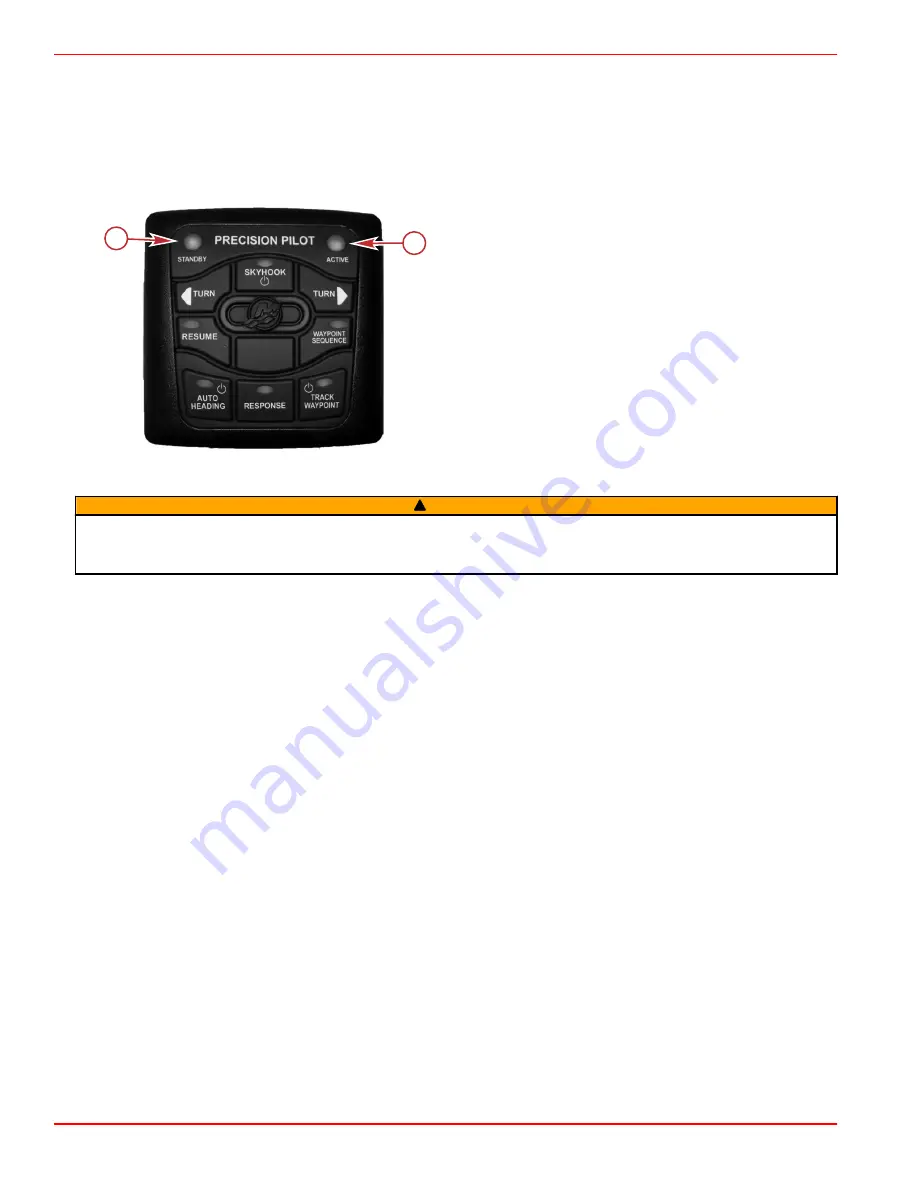
Section 2 - On the Water
Page 24
90-8M0093150
eng
MAY 2014
Autopilot Trackpad Lights
The autopilot trackpad includes lights to indicate when an autopilot mode is active (engaged) or in standby (disengaged). If the
standby light is illuminated, then the autopilot is disengaged (off). If the active light is illuminated, then the autopilot is engaged
(on).
Pressing the button for auto heading, track waypoint, or Skyhook will engage that mode, turning on both its respective light and
the active light.
NOTE: The standby light will flash on and off when the system is attempting to acquire the necessary GPS signals.
a -
Standby light
b -
Active light
Autopilot Modes
!
WARNING
Avoid serious injury or death. Inattentive boat operation can result in a collision with other watercraft, obstacles, swimmers, or
underwater terrain. The autopilot navigates a preset course, and does not automatically respond to hazards in the vicinity of
the boat. The operator must stay at the helm, ready to evade hazards and warn passengers of course changes.
The autopilot includes several modes that can steer your vessel to a specific compass heading or to destinations generated
from a chartplotter and GPS unit. If using a device to generate course information, you must be familiar with the operation of
that chartplotter and GPS unit before attempting to use the autopilot to steer your vessel. The autopilot does not control speed,
only direction, and it cannot sense hazards to navigation. These automatic modes do not relieve the operator of the
responsibility to stay at the helm and keep a vigilant lookout for other vessels, persons in the water, or hazards to navigation.
When using the autopilot with a chartplotter and a GPS unit to navigate along a series of waypoints (a route), be aware that the
boat will not travel to the precise location of the waypoint before initiating a turn to the next waypoint. Your chartplotter
establishes a zone called an arrival circle around the point, and the autopilot will announce arrival at the waypoint when the
boat enters that zone.
Skyhook Station Keeping
Your vessel may be equipped with the Skyhook station keeping feature. This system uses global positioning system (GPS)
technology and an electronic compass to automatically control shifting, throttling, and steering to maintain heading and
approximate position. This feature can be helpful when waiting for space near a fuel dock, waiting for bridges to open, or when
the water is too deep for an anchor.
Skyhook does not maintain an exact fixed position, but rather will hold the vessel in a fixed compass heading within an
approximate area. The size of this area is affected by the accuracy of the global positioning satellite system, the satellite signal
quality, the physical position of the satellites relative to the receiver, solar flares, and the proximity of the receiver on the vessel
to large structures (for example, bridges or buildings) and trees. Under some of these conditions Skyhook may be affected
enough that the system will disengage. The operator must remain at the helm whenever Skyhook is engaged and be vigilant for
changing conditions such as the presence of other vessels or swimmers or the disengagement of Skyhook.
Under typical operating conditions, Skyhook is capable of holding the vessel within a radius of 10 m (30 ft). However, this
distance may sometimes increase to a radius of 30 m (100 ft). Because Skyhook holds the boat in an approximate position, not
a precise one, it can cause your boat to collide with other objects close to your boat and cause damage. Do not use Skyhook
when your boat is close to a dock, piling, bridge, another vessel, or swimmer.
b
a
51879
















































